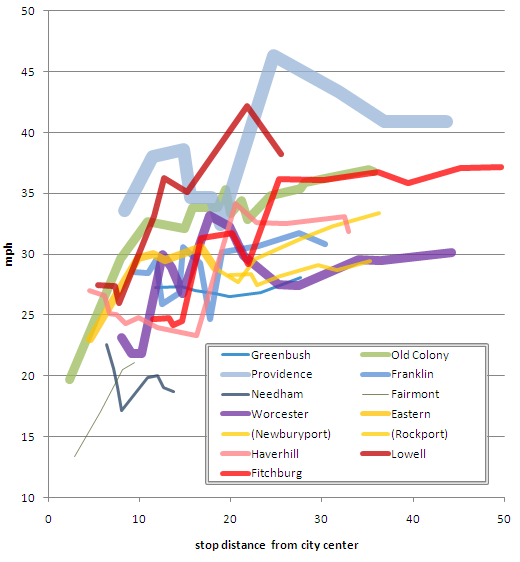This spring, I wrote about how the MBTA’s fares are really not that high. Fares went up on the order of 20 to 25%, and the T apparently expected ridership to fall by 5% or so. The numbers are in for the first month and while ridership did fall (the first decline, year-over-year, in 14 months), it was off by less than 1/10 of 1%.
There’s a local company which builds pricing software which is not surprised. They studied the base transit fare and calculated as long as it stayed under about $2.75 there would not be a major impact on ridership. Demand for transit is rather inelastic—people have to get to work—and they’re willing to pay an extra 60¢ a day (or $11 per month) in order to get to a job which pays many dollars per hour. For the average subway commuter, it’s still far cheaper to pay $70 for a monthly pass than to pay gas, tolls and (especially downtown, or in Kendall or Harvard) parking.
What’s interesting is where ridership fell. I expected that the increases in the cost of Commuter Rail to be a detriment to ridership. While transit and bus rose by 17% and 20%, commuter rail fares rose by 25-30%. And with higher fares to start, the nominal increase was $1.25 to $2.25. For monthly passes, which now range from $173 to $314, the increase in fares ranges from $38 to $64, which is not chump change. Commuter Rail customers are more likely to own cars than bus and transit users, and there was a lot of hand-wringing that commuters would abandon the rails and drive instead.
But that hasn’t happened. Even with lighter summer traffic, commuter rail posted gains. So did buses and boat traffic. The only declines were on The Ride (where fares doubled*) and on the Subway. Commuter Rail ridership is up. But the subway, where fares rose by a quarter and a nickel, is down.
However, the more I thought about it, the more it makes sense. While the subway prices stayed well within a range where they won’t have a major impact on demand, there is enough elasticity in supply to allow people to utilize other options. For most Commuter Rail riders, the trip is more than 10 miles and their only other option is driving, which is more expensive and subject to the whims of traffic. The cost of driving might be somewhat less marginally more, but it’s still more. So the supply is quite inelastic—even with fare increases the train is still cheaper than driving.
For subway riders, it’s a different story. Except for the Riverside and Quincy lines, most of the T’s ridership is concentrated within about 6 miles of downtown. Many subway riders have a commute which is only three or four miles long. The supply here is not constrained to transit or driving, but adds walking and cycling to the mix. With a mild summer (June was 1 degree below average, July and August 2 above) and expansion of bike sharing, as well as at-capacity rush-hour trains, it’s quite possible that many commuters looked at the fare hike and tested the elasticity of the short-distance travel supply. And that people looked at a mile-and-a-half ride on the train and decided to save $2 and take a half-hour walk. The price for walking or biking is essentially zero, so commuters were able to overlook the inconveniences of these modes due to the price savings. In other words, they pumped up their tires or put on their shoes.
Come winter, when it’s cold and rainy (or, like in 2011, snowy) these new riders may stream back towards the turnstiles (or, uh, Charlie Card machines). In any case, I doubt the drop in subway ridership is due solely to the rise in prices as much as it is due to riders exploring other options.
* I am torn how to feel about The Ride fares. On the one hand, paratransit is a lifeline for many disabled and disadvantaged groups who would otherwise not be able to get around without it. On the other hand, it commands a subsidy on the order of $40 per ride (if that was the rate of subsidy for all MBTA riders, the annual subsidy would be on the order of $15 billion per year—the cost of one Big Dig), and its ridership is growing exponentially. Paratransit is an important government service, but because it is shouldered by the T, a service for a few thousand riders a day is subsidized heavily by over a million other riders. A good solution, perhaps, would be sequestering funding for The Ride and funding it separately from the T at large.



